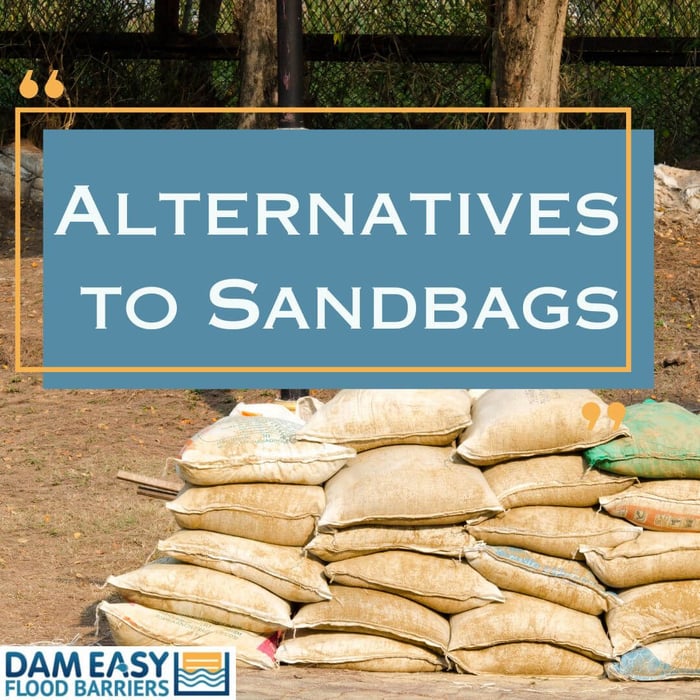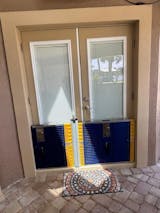Sandbags have always been the go-to method for preventing flooding. We've discovered over time that these basic bags aren't particularly effective or economical for many uses. Nevertheless, they lack the dependability, cost, and ease of deployment that bigger locations and building projects require. They may be suitable for domestic applications and low flood hazards.
Sandbags are no longer the preferred flood control technique because of new solutions that solve their drawbacks. Let's examine how sandbags function, where they fail, and what to employ in their place to provide flood protection.
Why do people use sandbags? History of sandbags.
Sandbags act as a barrier to direct flowing water away from a place when they are used as flood control. It doesn't produce a watertight seal, but it offers enough of a barrier for many low-risk scenarios, requiring only a few feet of height. Fine particles like silt and clay that are carried by the water as it passes through the bag are caught by the sand, which "fills in the gaps" between the sand to harden the barrier and stop water from passing through.
Burlap was once the material used to make sandbags, but today's bags are often constructed of polypropylene plastic, which can withstand weather damage and fast-moving water better. Though they may grow pricey, you can buy more advanced bags made for certain uses like long-term usage or fill upon contact with water.
Clay or dirt might also be used to fill conventional sandbags, but sand is preferable because it is non-porous and won't allow as much water through. Sand is also lightweight enough for simple construction, but when it gets wet, it becomes heavy enough to remain put. Sandbags typically weigh about 40 pounds when they are constructed.
The filling, tying, and placement of the sandbags in the appropriate configuration are labor-intensive steps in the construction of a sandbag barrier. Little obstacles could make this practical, but bigger sites make it expensive and difficult to complete on short notice. Even though the filling procedure can be automated, specialist equipment might not always be accessible.
Thus, even though a sandbag water barrier may appear to be the perfect answer at first, utilizing them really reveals a number of issues that more advanced methods may solve.
Why should you not use sandbags?
1. Increasing cost
Sandbags' equipment may be cheap, but they need a lot of labor hours and may incur costs for specialized tools, disposal, and transportation. It would take 11,700 sandbags and 455 man-hours to build a 4-foot dike that was 150 linear feet long. For this configuration, you should prepare to shell out more than $40,000, recovery fees included.
2. Significant Labor Demands
One of the main drivers of those high expenses is labor. Because of the high expense of shipping and the possibility of storage deterioration, sandbags normally cannot be delivered prefilled. Instead, teams must be built and filled on the spot. In an emergency, you'll normally need all hands-on deck to swiftly install a sandbag barrier.

3. Not Appropriate for Very Serious or Extended Flooding
Sandbags cannot be utilized for flood hazards with heights of more than a few feet or in already flooded regions. Also, because the bags might deteriorate with time, they aren't the best for persistent flooding. As the majority of the materials used to make sandbags aren't reusable, you would have to pay for the entire procedure again if you ever needed to build flood protection.
4. Limited Flexibility
Sandbags may be placed in many configurations, but they are difficult to transport. For instance, moving sandbags from a warehouse to a project site would probably be too expensive for a construction business.
5. Issues with Access in Emergency Situations
If you use sandbags, you run the danger of not being able to get supplies unless you have a stockpile of them on hand. Sandbags and sand may be difficult to get at local stores before a flood since other locals may be preparing in the same way. Also, if you're dealing with a sizable region, you can deplete the inventory of your neighborhood shops, leaving many homes without an option.
6. Sustainability Concerns
Sandbags are mostly expensive because of the labor, shipping, and landfill costs associated with recovery. These are crucial factors to take into account since floods cause sandbags to get tainted. Sand cannot be recycled because floodwater contains a variety of impurities, including toxic waste and sewage. Dumping fees are often associated with proper disposal.
Alternatives to Sandbags
Sandbags may be expensive and difficult to use, thus numerous flood sandbag substitutes have emerged that provide greater flexibility, easier setup, and lower costs. Large-scale projects now have access to more sophisticated technologies, including government sites, and commercial and construction flood protection.
Dry and Wet Floodproofing
Larger structures may take longer to dry floodproof, and it won't protect any area of the property outside of the building. For instance, floodproofing techniques are not permitted on building sites. Most panels aren't designed for high-velocity flow and waves, and others only provide a few feet of protection. In order to ensure that the structure can survive the effects of floods and offer enough waterproofing, this strategy will also require engineering skills.
On the other hand, wet floodproofing enables water to completely penetrate the structure. This plan calls for particular modifications, such as damage-resistant construction materials and safeguarded electrical systems, to reinforce the structure against the impacts of floods. Wet floodproofing is designed to reduce hydrostatic pressure, or the force caused when water pushes inward on a structure, in order to protect the building's structural integrity. This pressure is reduced by allowing water to pass through, ideally maintaining the structure in better condition.
Flood Barriers
Modern flood barriers for homes are easy to install and remove. They are made from lightweight yet robust materials that can easily withstand even the most severe floods.
Modern home flood barriers can be installed in a matter of several minutes, which often makes them the only chance to protect your home in case of a flash flood. Moreover, you don't need any special equipment or skills to install and remove them.

Flood barriers for home don't need much storage space, you can easily keep them in your garage, basement, or even on top of a cupboard or behind the door.
Multi-use, adjustable and efficient, modern flood barriers are probably the best alternative to sandbags on the modern market.
Inflatable and water-filled Dams
A fillable dam is often built over a body of water, although it may also be used to reduce flooding. To enhance volume, these substantial barriers are either inflated or filled with water and are constructed of a durable material like plastic or rubber. The dam's behavior and response to factors, such as the force of the water's current, can be affected by the filler choice, making it crucial.
Although other elements may vary depending on the product you select, this alternative is reusable and reasonably priced. Some may take a long time to deploy, making them difficult to use in an emergency, and some may provide different levels of protection for water that flows quickly. It might be difficult to pick the perfect one for various places because of their forms, which can vary greatly.
Flood barriers are frequently more reliable than fillable dams. It might be challenging to select the ideal type of dam for the scenario and keep the water from overflowing or breaking through the barrier due to the numerous factors that impact water movement and the integrity of the dam. These dams must be folded for storage, and folds might create stress spots that could result in the dam failing.
Do you want to learn more about modern flood control methods and alternatives to outdated sandbags? Follow Dam Easy on social media and get the latest updates about flood safety and floodproofing methods for homes and businesses.
Contact Dam Easy and let our team help you make informed decisions about floodproofing your home today!
Empangan Pintu Penghadang Banjir

$949.00
PINTU DAM EASY® FLOOD BARRIER Banjir menjadi lebih biasa di seluruh dunia. Apa yang pernah menjadi fenomena 100 tahun sekarang adalah trend bermusim yang mesti ditangani oleh pemilik rumah. Itulah sebabnya anda memerlukan Dam Door Flood Barrier Door… Read More



















